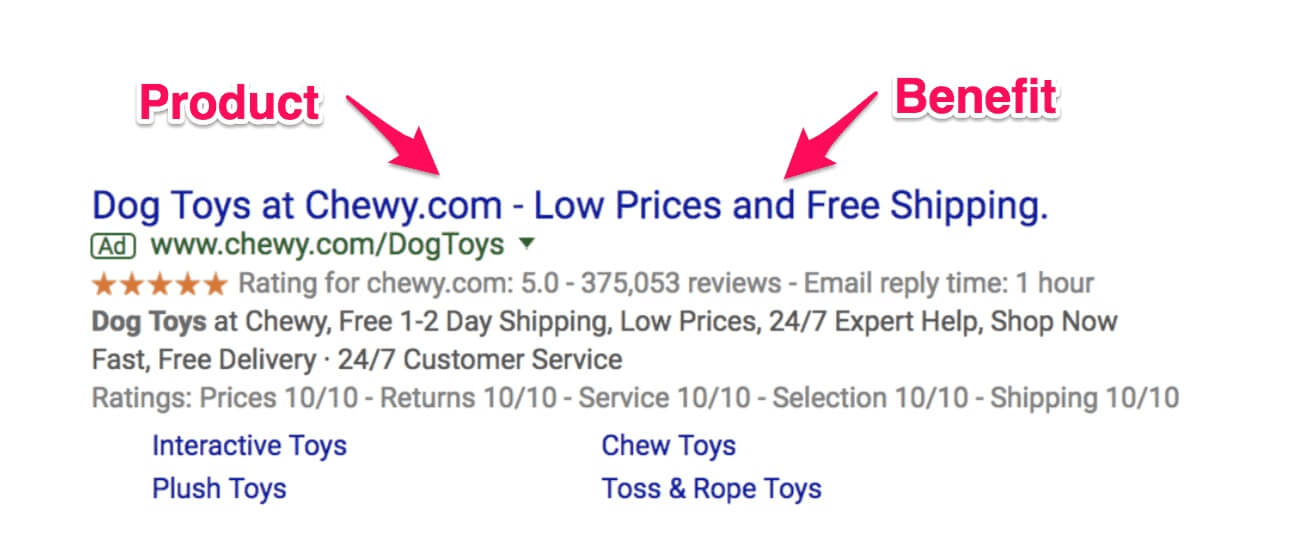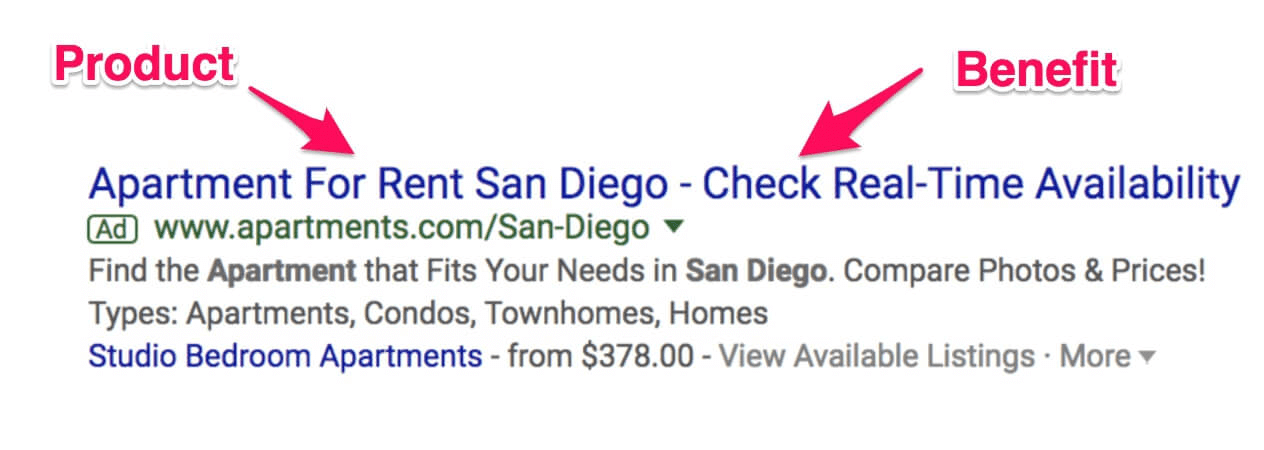There are a lot of essential components to focus on when you’re building an AdWords campaign – keywords, bidding strategies, quality scores, landing pages, conversions, etc.
AdWords has so many moving parts and data points it’s easy to overlook one of the most important components – THE AD ITSELF!
You can optimize your campaign and your landing pages all you want, but if your ad copy isn’t any good… Then you just planned the best party no one will attend.
Ads are the gateway to attracting searchers to your offer
A good AdWords text ad grabs a searcher’s attention, or even better, triggers an engaged emotional reaction.
A bad ad bores searchers and kills your quality score.
In this post we will look at some great ad copy! We will dissect some successful ads, so you can ethically steal their winning strategy and use it in your ad writing.
We also share three proven copywriting formulas you can use to create engaging ads.

Maximize your text ad visibility
Text ads don’t give you a lot of space to grab the searcher’s attention. Maximizing your ad visibility by building out every component of your ad is a great way to make your ad impressions stand out.
The ad below combines visibility with calls to action, and benefits that meet the searcher’s goals.
This ad displays on the ultra-competitive, high commercial intent search term, “hotels in New York City.”

Headline: The headline in this ad immediately calls your attention to a benefit. It lets the searcher know that clicking the ad will allow them to accomplish their objective. It also qualifies a comfortable price point.
Description lines: The description contains the keyword, and lists more easy to read benefits. The “No Ads or Pop-ups” text is an effective way to let the searchers know they won’t receive any unwanted promotions if they click through.
Extensions: This ad is loaded up with ad extensions. The extensions maximize the ad space. Even if the searcher doesn’t click the extension links, they still get more information about how this result will help them achieve their goal.
What can you learn from this ad: This ad is a great example of how to maximize ad visibility, and how benefit driven ad copy can instantly connect with a searcher’s needs.
Write ads that solve your customer’s problems, and reassure their concerns
The example below compares and contrasts two ads that are displayed on a search for “plumbers in Philadelphia.”
The RotoRooter ad is a great example of prioritizing the searcher’s mindset.
The writer for the RotoRooter ad nailed every part of drawing the searcher’s attention, offering an immediate benefit, reassuring their concerns, and providing the information they need to take action.
 Headline: The headline includes an immediate benefit related offer that also reassures price concerns.
Headline: The headline includes an immediate benefit related offer that also reassures price concerns.
Description lines: The description includes keyword visibility, more benefits, price reassurance, and social proof.
Extensions: They’ve enabled their call extension, which offers the searcher an immediate solution. They have also built out multiple call-out extensions, and a review extension.
In contrast with the ad above it, the RotoRooter ad is much more compelling. The ad extensions also maximize their chance of winning a conversion.
The shorter ad for Zoom Drain is not targeted for this search, and does nothing to entice or qualify clicks. It appears this ad is throwing money down the drain. ?
The ad results on this search are a great example of what to do, and what not to do when designing [and targeting] your ad.
What can you learn from this ad: Copy that offers a solution is compelling. Copy that offers a solution, overcomes fears or objections, provides an opportunity to take immediate action and provides an incentive to take that action is outstanding.
Try to think of the immediate benefit your searchers hope to get when writing your ad copy. Also, think about any fears that would prevent searchers from clicking your ad while trying to obtain that benefit. The more you can make the copy both compelling and reassuring, the more likely you are to win the click.
How to write emotionally compelling text ads
It’s not easy to write an emotionally compelling text ad with limited characters available. But if you can pull it off, engaging a searcher gives you a superior chance to win a conversion.
The majority of studies on purchasing psychology have shown that as much as we want to be rational, our decisions are usually tied to deep underlying emotions.
The ad below for marriage counseling doesn’t shy away from the heightened emotional component of their services.
This is a case where the copy is so compelling that the writer was able to do more with less.
The ad writer delivers a powerful message that connects with the searcher’s problem. The ad also avoids overwhelming the searcher with too much information. Let’s break this ad down a little further.

Headline: The headline targets the search keyword “marriage counseling” and calls attention to searcher’s ultimate goal “Rekindle Your Relationship.”
Display URL: The ad writer even included emotionally compelling copy in the display URL.
Description lines: The description lines are where this ad really succeeds.
The call to action recognizes the searcher’s problem and offers a solution in a single line of text. Even though I’m not in the market for counseling, I still want to click this ad. After all, who doesn’t want to “Get Over Years of Disappointment?”
The engaging emotional copy is followed by an irresistible offer – “110% Money Back.” This offer is so reassuring it creates an element of wonder and disbelief. Who offers a 110% guarantee?
The only thing this ad is missing might be a phone call extension.
I included the second ad in the results to contrast the two different ad writing approaches.
Although the second ad is well optimized, it’s just not as engaging. It also misses the mark with its description. “Affordable and Effective” is probably a better description for a divorce lawyer than a marriage counselor.
Without access to the back-end data, it’s tough to know which ad converts better. But from a copywriting perspective, the first ad is a clear winner.
What you can learn from this ad: Test aggressive emotional copy and direct copy in your text ads.
Some products and services naturally have a heightened emotional element. If you’re advertising in one of those areas, meet the searcher at their emotional distress point with your ad and offer a compelling solution.
If you know your searcher is likely to have a distressed mindset, test ads that don’t overwhelm the reader with too much information.
Keys to a successful AdWords text ad
Here’s what we’ve learned from the text ad examples we’ve studied:
- Write headlines that match your target customers needs
- Focus on benefits in headlines
- Use extensions to maximize your ad space
- Reduce any friction that might prevent a click with reassuring benefits
- Meet your target customer at their pain point and provide a solution
- Choose a descriptive or engaging display URL
- Use keywords in your description lines
- Be granular with your ad writing and targeting
Now let’s look at some copywriting formulas that can help you write a compelling text ad.
Text ad copywriting formulas
The Russell Brunson “get this without that ” formula.
The “get this without that” formula is great a way to engage your searcher on an emotional level. This formula helps you write ads that speak to the benefit the searcher wants, while reassuring they won’t experience the pain or frustration they don’t want.
Here are some examples of what this formula looks like:
“Lose weight without dieting”
“Design your dream home without a contractor”
“Make delicious dinners in minutes”
Here’s how to use this formula for your product or service:
Get this – the compelling benefit your product or service offers, without that – The main pain point or frustration your product or service relieves.
Attention + Interest + Urgency formula
The most tried and true copywriting formula is AIDA – [attention, interest, desire, action].
Attention + Interest + Urgency is like a condensed version of the AIDA formula. Here’s a template you can use for this formula.
Headline = Attract Attention (be relevant)
Description line two = generate interest (be useful)
Description line three = ask for the click (show value)
To read a complete description of this formula see this post by Amy Hebdon of Blast.
Product + Benefit formula
The product plus benefit formula was evident in each of the ads we dissected in this post. It’s simple way to write your headline and build out your descriptions.
Here are some examples of the Product + Benefit formula



Build a text ad swipe file
The best way to write winning ads is to leverage what’s already working. Keep a swipe file of the best ads you see. When it comes time to write your ads, use your swipe file to help you write great ad copy.
You can download the PDF of this post here and ad it to your AdWords swipe file.

And always remember to test multiple ads and use your performance metrics to determine the winner. Some ad writing formulas will work better than others, depending on the keyword, context and other environmental factors.
This is why testing multiple ads is so important. Google gives us the opportunity to test many ads at a time. Be sure to use this to your advantage.
